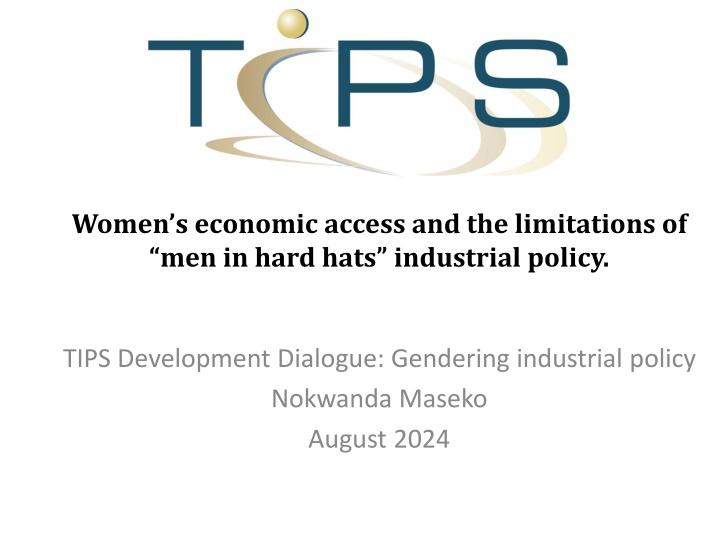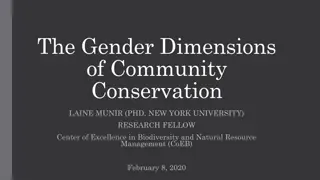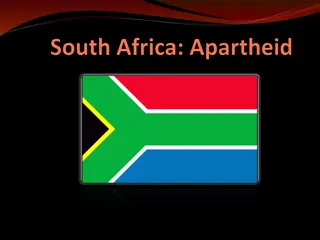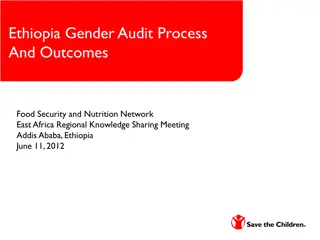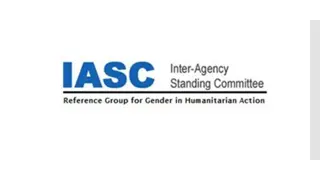Gender Disparities in Post-Apartheid Industrial Policy: Challenges and Solutions
Post-apartheid industrial policy in South Africa has perpetuated gender and racial disparities, particularly in manufacturing. Women, especially Black women, face barriers to entry and advancement, being clustered in low-paying sectors. There is a lack of focus on services supporting gender-inclusive industrial policies. The data highlights the unequal distribution of women in various industries and occupations, revealing deep-rooted inequalities that need to be addressed for a more inclusive and equitable industrial landscape.
Download Presentation

Please find below an Image/Link to download the presentation.
The content on the website is provided AS IS for your information and personal use only. It may not be sold, licensed, or shared on other websites without obtaining consent from the author.If you encounter any issues during the download, it is possible that the publisher has removed the file from their server.
You are allowed to download the files provided on this website for personal or commercial use, subject to the condition that they are used lawfully. All files are the property of their respective owners.
The content on the website is provided AS IS for your information and personal use only. It may not be sold, licensed, or shared on other websites without obtaining consent from the author.
E N D
Presentation Transcript
Womens economic access and the limitations of men in hard hats industrial policy. TIPS Development Dialogue: Gendering industrial policy Nokwanda Maseko August 2024
Context Post-apartheid industrial policy entrenched exclusion started pre- 1994 Even with overall decline in manufacturing over the years, industrial SA industrial policy remains very much about men in hard hats Access remains both gendered and racialised, where race is often a good indicator of location within industry and occupation While the Black industrial class has grown, benefits have not translated to all communities, especially among the already poor, and women Black women are still least likely to be in paid employment or business ownership When they are in employment, they are more likely to be in low-level occupations where pay is low and sometimes there are no benefits In business ownership, they are more likely to be in the informal sector where incomes are also low, and minimal if any infrastructure exists Minimal focus has been given to services (including social services) that support industrial policy
Share of employment by Industry (where employment exceeds 10%), disaggregated by gender Source: Calculated from Quarterly Labour Force Survey data downloaded from Stats SA from https://www.statssa.gov.za/ in March 2024 using SuperWeb online facility.
Share of women's employment by industry, disaggregated by race, 2010 - 2022 Source: Calculated from Quarterly Labour Force Survey data downloaded from Stats SA from https://www.statssa.gov.za/ in March 2024 using SuperWeb online facility.
Share of womens employment in manufacturing by occupation, disaggregated by race, 2010, 2015 and 2021 60% 50% 40% 30% 20% 10% 0% Professionals, technical & Elementary occupations & Legislators, senior officials and Legislators, senior officials and Legislators, senior officials and Clerks, service, shop & market Elementary occupations & Clerks, service, shop & market Elementary occupations & Clerks, service, shop & market Professionals, technical & Professionals, technical & Craft and related trades workers Craft and related trades workers Craft and related trades workers associate professionals associate professionals associate professionals & plant/machine operators & plant/machine operators & plant/machine operators domestic workers domestic workers domestic workers sales workers sales workers sales workers managers managers managers African Coloured/Asian White 2010 2015 2021 Source: Calculated from Quarterly Labour Force Survey data downloaded from Stats SA from https://www.statssa.gov.za/ in March 2024 using SuperWeb online facility.
Small business ownership by gender and race African men Coloured/Asian men White men African women Coloured/Asian women White women % women (right axis) % black women (right axis) 2 000 100% 1 800 90% 1 600 80% 1 400 70% 1 200 60% 1 000 50% 800 40% 600 30% 400 20% 200 10% - 0% 201020152019 Q1 Q2 Q3 Q4 Q1 Q2 Q1 Q2 Q3 Q4 201020152019 Q1 Q2 Q3 Q4 Q1 Q2 Q1 Q2 Q3 Q4 annual average 2020 2021 2022 annual average 2020 2021 2022 Formal sector (Including agriculture) Informal sector (Including agriculture) Source: Makgetla, N. 2023. Small business in industrial policy. TIPS Working paper Black women s business ownership is largely concentrated in the informal sector, though with a decline between 2010 and 2022 In the formal sector, women account for around a quarter of business ownership, but half of that is white women Black women account for less than 15% of formal business ownership
Dtic incentives, 2017/18 2020/21 100% 3.0 90% 2.5 Billions of nominal Rand 80% 2.0 70% 1.5 60% 1.0 50% 0.5 40% 0.0 Mining and mineral Chemicals, pharmaceuticals Agriculture Innovation Automotive CT/FL Film and TV Agroprocessing Business process services Wood, paper and furniture Industrial infrastructure 30% 20% 10% 0% 2017/18 2018/19 2019/20 2020/21 Gauteng Western Cape Mpumalanga Eastern Cape Limpopo North West KwaZulu-Natal Free State Northern Cape 2017/18 2018/19 Manufacturing Source: DTIC Annual incentive reports 2017/19 2020/21 Four provinces receive almost all of dtic s incentives, with Gauteng being the largest recipient In part linked to the location of the automotive sector Automotive manufacturing has been the largest recipient of dtic incentives, followed by chemicals and pharmaceuticals which are dominated by men, both in employment and ownership Agro-processing and CTFL both of which have a large share of women received less than R700 million in 2018/19
Industrial policy and poor economic outcomes for women Factors contributing to women s poor economic outcomes Existing inequalities make it difficult for women to participate in industrial policy without clear intervention Women have limited asset ownership to use as collateral for private financial assistance This includes property ownership Though Black women more likely to fully own their property, but these often valued below R500k Location at low-level occupations also limits incomes More pronounced for Black women who are also more likely to be in rural areas where there is under-investment (Black) Women are also more likely to be in informal business ownership, where support is limited Time-use also a key factor, with women in unpaid or under-pain labour SA industrial policy has continued to maintain and support industries established before or under apartheid Mainly heavy industries where women are under-represented Also maintains the spatial inequality created prior to, and under apartheid Both IPAP and the Masterplans gave minimal effort to prioritise women s access in a clear way Neither mapped out a clear path for women s increased participation in industrial policy Similar under-investment in (social) services that enable industrial policy
Some take-aways Women s access to industrial policy remains limited by a focus on hard hats industries Key industrial policy frameworks never outlined how women s participation will be increased Instead, (Black) women are over-represented in (social) services where the state is a key employer But also where funding has been decreasing in real terms Improvement requires an all-of-government and private sector solutions to: Address factors keeping women from economic participation Increase investment in social services like education and health Facilitate women s access to hard hats industries by utilising available industrial policy tools
Women and power in value chains Women have limited power within value chains, and the economy more broadly Largely driven by past inequalities that have not been addressed These include spatial inequality, which limits access to economic opportunities, Over-representation in low-level occupations, even in sectors where they account for high share of employment, Limited asset ownership, Available industrial financing focuses on already established sectors and industries where women are under-represented Women cannot gain power in value chains without addressing existing structural inequality requires public and private interventions Industrial policy must also have a clear plan for supporting women to enter the industrial base
